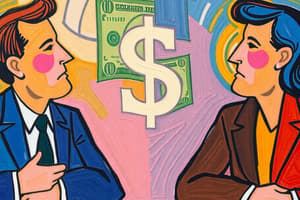Podcast
Questions and Answers
What are internal drive factors exemplified by?
What are internal drive factors exemplified by?
- Peer pressure
- Fear of failure
- Hunger (correct)
- Social relationships
Which concept best describes the feeling of pleasure experienced at the moment?
Which concept best describes the feeling of pleasure experienced at the moment?
- Anticipating
- Wanting
- Desiring
- Liking (correct)
What is an example of a primary reinforcer?
What is an example of a primary reinforcer?
- Money
- Praise
- Food (correct)
- Material possessions
Which theory emphasizes the relationship of learning to reward systems?
Which theory emphasizes the relationship of learning to reward systems?
What aspect of motivation does the dopamine system primarily relate to?
What aspect of motivation does the dopamine system primarily relate to?
Which of the following is NOT a component necessary for achieving homeostasis?
Which of the following is NOT a component necessary for achieving homeostasis?
Which of the following best describes 'incentive salience'?
Which of the following best describes 'incentive salience'?
What is the main focus of the psychodynamic approach to motivation?
What is the main focus of the psychodynamic approach to motivation?
What need represents the ultimate human motive according to Maslow's Hierarchy of Needs?
What need represents the ultimate human motive according to Maslow's Hierarchy of Needs?
What primarily triggers the feeling of thirst in the body?
What primarily triggers the feeling of thirst in the body?
Which of the following best describes self-transcendence in Maslow's theory?
Which of the following best describes self-transcendence in Maslow's theory?
Which type of reservoir is primarily involved in thirst regulation?
Which type of reservoir is primarily involved in thirst regulation?
According to Maslow's later concepts, how rigid is the hierarchy of needs?
According to Maslow's later concepts, how rigid is the hierarchy of needs?
What does Hull's theory propose regarding behaviors that reduce drives?
What does Hull's theory propose regarding behaviors that reduce drives?
Which of the following needs is NOT considered a part of Maslow's hierarchy?
Which of the following needs is NOT considered a part of Maslow's hierarchy?
What is emphasized as a part of aesthetic needs in Maslow's Hierarchy?
What is emphasized as a part of aesthetic needs in Maslow's Hierarchy?
Why has drive theory faced criticism?
Why has drive theory faced criticism?
Which statement accurately reflects drive theory's integration of processes?
Which statement accurately reflects drive theory's integration of processes?
What can hinder individuals from focusing on self-actualization according to Maslow?
What can hinder individuals from focusing on self-actualization according to Maslow?
What role do osmotic sensors play in thirst detection?
What role do osmotic sensors play in thirst detection?
What motivates humans to engage in activities for intrinsic satisfaction rather than external rewards?
What motivates humans to engage in activities for intrinsic satisfaction rather than external rewards?
How does the body respond to a detected drop in extracellular fluid?
How does the body respond to a detected drop in extracellular fluid?
In Maslow's hierarchy, which need involves the pursuit of knowledge and understanding?
In Maslow's hierarchy, which need involves the pursuit of knowledge and understanding?
What might account for behaviors like dieting or watching horror movies?
What might account for behaviors like dieting or watching horror movies?
Flashcards
Homeostasis
Homeostasis
A state of internal physiological equilibrium that the body strives to maintain.
Set Point
Set Point
A fixed level that maintains homeostasis.
Motivation
Motivation
A process that energizes, directs, and sustains behavior.
Internal Drive Factors
Internal Drive Factors
Signup and view all the flashcards
External Incentive Factors
External Incentive Factors
Signup and view all the flashcards
Primary Reinforcers
Primary Reinforcers
Signup and view all the flashcards
Secondary Reinforcers
Secondary Reinforcers
Signup and view all the flashcards
Wanting
Wanting
Signup and view all the flashcards
Intracellular fluid
Intracellular fluid
Signup and view all the flashcards
Extracellular fluid
Extracellular fluid
Signup and view all the flashcards
Thirst
Thirst
Signup and view all the flashcards
Drives
Drives
Signup and view all the flashcards
Drive Reduction Theory
Drive Reduction Theory
Signup and view all the flashcards
Limitations of Drive Reduction Theory
Limitations of Drive Reduction Theory
Signup and view all the flashcards
Increasing Drives Instead of Reducing
Increasing Drives Instead of Reducing
Signup and view all the flashcards
Safety Needs
Safety Needs
Signup and view all the flashcards
Belongingness and Love Needs
Belongingness and Love Needs
Signup and view all the flashcards
Esteem Needs
Esteem Needs
Signup and view all the flashcards
Cognitive Needs
Cognitive Needs
Signup and view all the flashcards
Aesthetic Needs
Aesthetic Needs
Signup and view all the flashcards
Self-Actualization
Self-Actualization
Signup and view all the flashcards
Self-Transcendence
Self-Transcendence
Signup and view all the flashcards
Flexibility of Needs
Flexibility of Needs
Signup and view all the flashcards
Study Notes
Motivation Overview
- Motivation is a condition that energizes behavior and influences direction, persistence, and vigor of goal-directed behavior.
- A goal is a cognitive representation of a desired state.
- Subjectively, motivation is experienced as conscious desire.
Motivation Arises From Two Sources
- Internal drive factors (e.g., hunger)
- External incentive factors (e.g., food)
Incentives
- Primary reinforcers act as rewards independently of prior experience.
- Secondary reinforcers act as rewards through learning about their relationship to other events.
Incentive Motivation & Reward
- Incentive motivation is associated with affect (pleasure and displeasure).
- Most incentives are learned.
- Incentive salience connects objects/events to anticipated pleasure.
- Wanting is the anticipation of pleasure (e.g., dopamine system).
- Liking is the actual pleasure experienced in the moment.
Perspectives on Motivation: Homeostasis and Drives
- Homeostasis is a state of internal physiological equilibrium.
- The body strives to maintain homeostasis at a set point (fixed level).
- Homeostasis requires a sensory mechanism to measure internal state and detect changes.
- A control center receives sensory information and compares it to the set point.
- A response activates systems to reduce the difference between the internal state and the set point.
Body Temperature & Homeostasis
- Physiological responses (e.g., sweating, shivering) and behavioral responses (e.g., finding shade, removing clothing) help maintain body temperature.
- Neurons in various brain parts (especially the hypothalamus) detect changes and trigger physiological & behavioral responses.
Thirst as a Homeostatic Process
- Two types of fluid reservoirs in the body: intracellular and extracellular.
- Thirst occurs when loss of extracellular fluid is detected by blood pressure sensors and neurons in veins/organs responding to reduced pressure.
- Loss of intracellular fluid triggers osmotic sensors in the hypothalamus.
Drive Reduction Theory
- Drives are states of internal tension.
- They motivate behavior to reduce tension (e.g., hunger, thirst).
- Hull (1943) proposed that behaviors reducing drives are reinforced.
- Over time, animals learn which behaviors best reduce certain drives.
Perspective on Motivation: Instinct Theories
- Instinct is a fixed action pattern.
- It's an inherited characteristic common to all members of a species.
- An instinct automatically produces a specific response to a particular stimulus (e.g., suckling, crying).
Perspective on Motivation: Approach and Avoidance Motivation
- Approach-avoidance theories consider a person's environment and context.
- Optimal arousal theory (Hebb, 1955) proposes optimal levels of stimulation for a given environment.
- Moderate stimulation is best; too little or too much is undesirable.
- Behavioural Activation System (BAS) is roused by signals of potential reward.
- Behavioral Inhibition System (BIS) responds to signals of potential pain/punishment.
Perspective on Motivation: Social Cognitive Theories on Motivation
- Social cognitive theories explain behavior by interactions between cognition and social environment.
- Incentives, expectancies, and internal/external motivation are key concepts.
- Drive theory views drives as physiological forces, while incentives are environmental stimuli that pull organisms towards goals.
Expectancy x Value Theory
- Motivation is the product of expectancy (believing behavior will lead to a goal) multiplied by the incentive value (a person's evaluation of the goal).
Two Kinds of Motivation
- Extrinsic motivation: performing an activity to obtain external reward or avoid punishment.
- Intrinsic motivation: performing an activity for its inherent satisfaction.
Social Cognitive Theories on Motivation: Self-Efficacy
- Self-efficacy is the subjective perception of one's ability to successfully perform a task.
- Self-regulation occurs when monitoring progress.
- Lack of progress triggers adjustment efforts in goal pursuit.
Perspectives on Motivation: Psychodynamic and Humanistic Approaches
- Psychodynamic theory suggests that behavior is often driven by unconscious motives.
- Humanistic approaches emphasize creativity, free will, and human potential.
Maslow's Hierarchy of Needs
- A progression of needs, with deficiency needs at the bottom and growth needs at the top.
- Deficiency needs (physiological, safety, belonging, esteem) must be met before pursuing higher growth needs.
- Examples of higher needs include cognitive, aesthetic, and self-actualization needs.
McClelland's Learned Needs Theory
- He proposed that the need for achievement, affiliation, and power are learned motivators.
Self-Determination Theory
- Assumes humans are inherently active, intrinsically motivated, and oriented toward development.
- Three fundamental psychological needs support healthy development: competence, autonomy, and relatedness.
Humanistic approach: Positive psychology
- Positive psychology studies conditions and processes that enhance functioning. It examines well-being, strengths, and virtues to lead a fulfilling life.
- Optimal subjective well-being facilitates effective functioning.
- Flow state describes total involvement in an activity optimized by challenges and skills.
Studying That Suits You
Use AI to generate personalized quizzes and flashcards to suit your learning preferences.
Related Documents
Description
Explore the fundamental concepts of motivation, including internal drive factors and external incentives. This quiz delves into the dynamics of incentive motivation, reward systems, and the significance of homeostasis in understanding human behavior. Test your knowledge on how motivation energizes behavior towards goal attainment.




